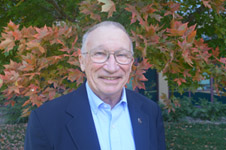Natural Resources, School of
Document Type
Article
Date of this Version
6-2022
Citation
Diffendal, Robert F. 2022. Fossils on the Floor Mosaics in the Rotunda of the Nebraska State Capitol Second Edition. Lincoln, Nebraska, Conservation and Survey Division, UNL, 78 pp.
Abstract
The idea for this project arose during a field trip to the Nebraska State Capitol led by my long-time friend and colleague, Joe Hannibal, of the Cleveland Museum of Natural History, during the Geological Society of America’s North-Central Section Meeting in Lincoln, Nebraska, on Saturday, April 26, 2014. One of Joe’s interests is historical buildings and their building stones. He put together a very useful guidebook to the building and its decorative stones (Hannibal, 2014) that we used on our tour.
One of the many places that we visited was the State Capitol Archives, located in the basement, where the Capitol Archivist, Karen Wagner, showed us many items in the collection. The most interesting to me, a paleontologist by training, were the large drawings done in color on tissue by the famous Nebraska paleontologist, Erwin H. Barbour, in the late 1920s. These images depict many of the fossils found in the mosaics on the floor of the Capitol Rotunda. Captivated, I thought that these drawings might interest others, especially children who visited the capitol or had an interest in dinosaurs and other fossils. Thus began the start of this project that has led to a coloring and activities book for kids and to this book for people who want to know more about the mosaics and the fossils represented in them.
This guide for older kids, including adults who still have a bit of a kid in them, is a progress report on what I have learned so far about the fossil mosaics, including who chose the fossils to depict and who designed and made the mosaics. It is a progress report because I probably have not found all of the information that exists on the history of the mosaics or even all of the Barbour drawings that may exist. As with so many research projects that I have worked on through the years, this one seemed easy to design and work up in the beginning, but has proven to be far from simple. Historical accounts are incomplete, and the ones that I have located are sometimes contradictory. At any rate, I will continue to look for more information after this book is published and will try to update it from time to time if important new information comes into my hands.
I have divided the book into several sections. First, I will tell you about the people involved in deciding which fossil plants and animals to use in the mosaics and why they chose them. I will then discuss the materials used to make the mosaics, then who picked the fossils, then the drawings made by Barbour that were submitted for possible use by the mosaic artist Hildreth Meière, then about construction of the mosaics, and a short note on the concept and design for the mosaics. Images of all of the individual animals and plants appearing in the mosaics together with the Barbour colored drawings are reproduced. A section of definitions offers information about the fossil animals and plants and the meanings of some technical words and terms used in this book. Finally, a list of books and articles will guide you to more information about the mosaics and the fossils.
Included in
Art and Design Commons, Art Practice Commons, Geology Commons, Geomorphology Commons, Hydrology Commons, Stratigraphy Commons



Comments
EC-24b